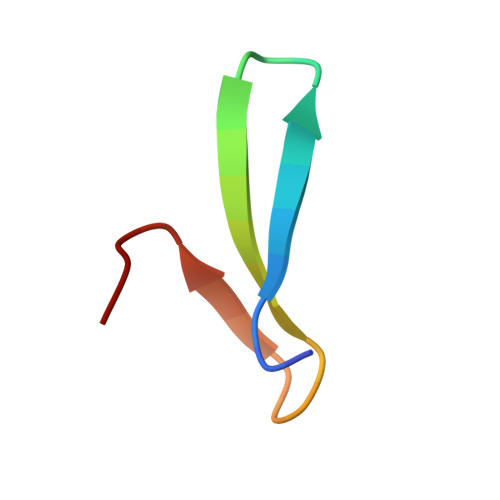Folding kinetics of WW domains with the united residue force field for bridging microscopic motions and experimental measurements.
Zhou, R., Maisuradze, G.G., Sunol, D., Todorovski, T., Macias, M.J., Xiao, Y., Scheraga, H.A., Czaplewski, C., Liwo, A.(2014) Proc Natl Acad Sci U S A 111: 18243-18248
- PubMed: 25489078
- DOI: https://doi.org/10.1073/pnas.1420914111
- Primary Citation of Related Structures:
2MW9, 2MWA, 2MWB, 2MWD, 2MWE, 2MWF - PubMed Abstract:
To demonstrate the utility of the coarse-grained united-residue (UNRES) force field to compare experimental and computed kinetic data for folding proteins, we have performed long-time millisecond-timescale canonical Langevin molecular dynamics simulations of the triple β-strand from the Formin binding protein 28 WW domain and six nonnatural variants, using UNRES. The results have been compared with available experimental data in both a qualitative and a quantitative manner. Complexities of the folding pathways, which cannot be determined experimentally, were revealed. The folding mechanisms obtained from the simulated folding kinetics are in agreement with experimental results, with a few discrepancies for which we have accounted. The origins of single- and double-exponential kinetics and their correlations with two- and three-state folding scenarios are shown to be related to the relative barrier heights between the various states. The rate constants obtained from time profiles of the fractions of the native, intermediate, and unfolded structures, and the kinetic equations fitted to them, correlate with the experimental values; however, they are about three orders of magnitude larger than the experimental ones for most of the systems. These differences are in agreement with the timescale extension derived by scaling down the friction of water and averaging out the fast degrees of freedom when passing from all-atom to a coarse-grained representation. Our results indicate that the UNRES force field can provide accurate predictions of folding kinetics of these WW domains, often used as models for the study of the mechanisms of proein folding.
Organizational Affiliation:
Baker Laboratory of Chemistry and Chemical Biology, Cornell University, Ithaca, NY 14853-1301; Biomolecular Physics and Modeling Group, Department of Physics, Huazhong University of Science and Technology, Wuhan 430074, China; Laboratory of Molecular Modeling, Faculty of Chemistry, University of Gdańsk, 80-308 Gdańsk, Poland;














